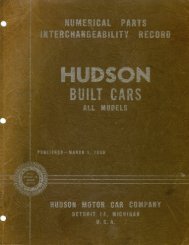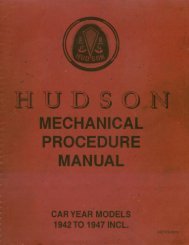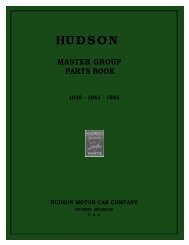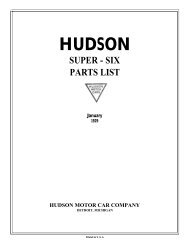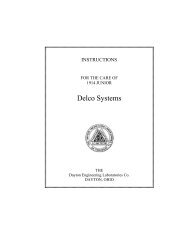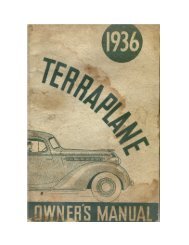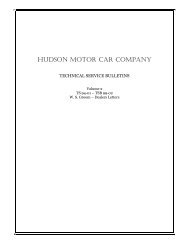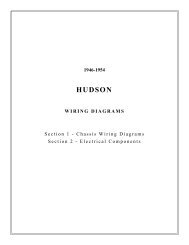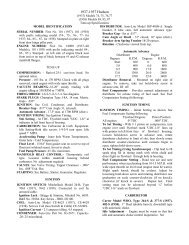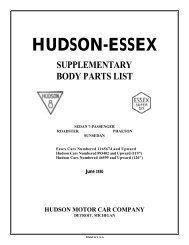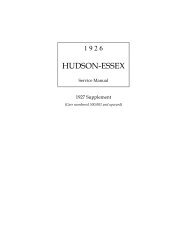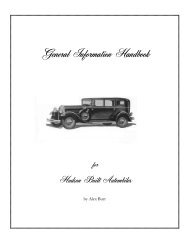1948-1952 Shop Service Manual - - Hudson-Essex-Terraplane Club
1948-1952 Shop Service Manual - - Hudson-Essex-Terraplane Club
1948-1952 Shop Service Manual - - Hudson-Essex-Terraplane Club
You also want an ePaper? Increase the reach of your titles
YUMPU automatically turns print PDFs into web optimized ePapers that Google loves.
9 - 6 OVERDRIVE<br />
times when it is desirable to return to direct drive for more power<br />
without reducing the car speed to the point where the overdrive<br />
would normally release.<br />
Under such circumstances, the driver merely presses the accelerator<br />
pedal beyond the wide-open position. Through suitable electrical<br />
controls, this releases the :solenoid, urging the pawl toward<br />
release from the control plate. However, due to the driving torque<br />
reaction, the pawl is held, and cannot move to release until the<br />
torque is momentarily relieved. This is accomplished by interrupting<br />
the ignition, whereupon the pawl snaps to release, which immediately<br />
restores the ignition. When the overdrive has been thus<br />
disengaged the roller clutch carries the direct drive, and the driver<br />
may hold it in this condition at his pleasure, until he chooses to<br />
reengage overdrive by merely lifting his foot from the accelerator<br />
momentarily. Thereupon the overdrive is resumed, unless the car<br />
speed has in the meantime fallen below the overdrive release point.<br />
the free-wheeling and the overdrive, there are times as<br />
when descending long steep grades, where it may be<br />
desirable to use the frictional drag of the engine as a<br />
brake.<br />
Under such circumstances, the overdrive dash control<br />
may be pulled out, swinging the control lever, Figure 9,<br />
forward, thus moving the shift rail and shift fork backwards,<br />
shifting the sun gear so that the lockup teeth will<br />
engage the corresponding teeth of the pinion cage. This<br />
causes the entire group of working parts to revolve as a<br />
unit, duplicating in all respects the action of the conventional<br />
transmission.<br />
In order to thus lock up the unit, if the car is in<br />
motion, it is necessary to open the throttle, to assure<br />
that all parts revolve together, or to release the overdrive,<br />
if engaged, by pressing the accelerator pedal to<br />
the floor, pulling out the overdrive dash control at the<br />
same time. Thereafter, the car will have the usual<br />
conventional drive until the driver chooses to push the<br />
overdrive dash control in, which may be easily done at<br />
any time.<br />
Since the roller clutch will not transmit a reverse<br />
drive, it is necessary for the lockup mechanism to be<br />
used whenever it is desired to reverse shift mechanism,<br />
which pushes the shift rail to the rear, independently of<br />
the overdrive control lever, whenever the transmission<br />
is shifted into reverse.<br />
ELECTRICAL<br />
While the mechanical structure of the overdrive unit<br />
just described, may be considered the working portion<br />
of the combination, its automatic action is controlled<br />
entirely by the external electrical control system. This<br />
system consists of certain units, connected by a wiring<br />
circuit. Figure 10.<br />
FIGURE 9<br />
CONVENTIONAL DRIVE:<br />
Although the normal procedure is to operate that unit as<br />
above, taking advantage of<br />
SPEED-CONTROLLED OPERATION:<br />
At low car speeds, the electrical control system is<br />
completely inactive. Whenever the car speed reaches the<br />
predetermined cut-in point, (18 to 21 miles per hour)<br />
centrifugal force, acting upon the revolving governor<br />
weights, is sufficient to cause the governor contacts to<br />
close.



